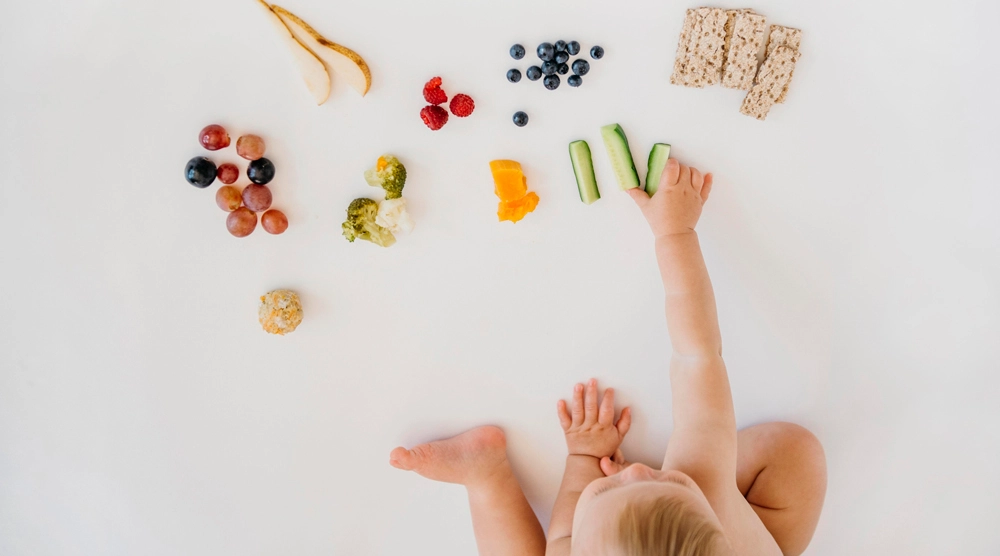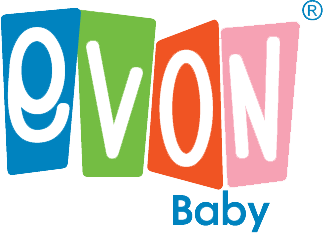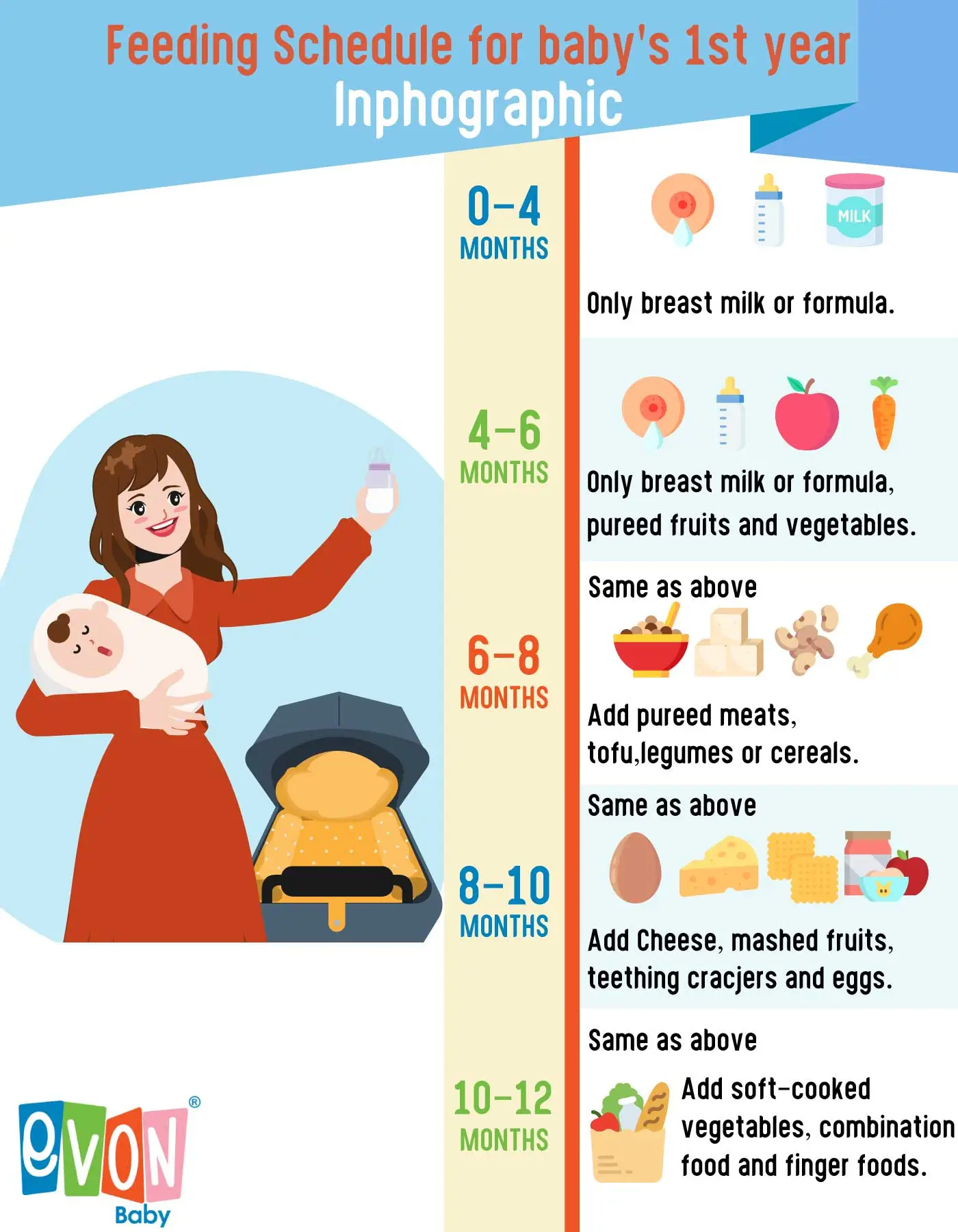Feeding Schedule For Baby’s 1st Year

Child Feeding and the appropriate amount for each meal and at each age
Your child begins eating after the fourth or sixth month and becomes a complement to breastfeeding, then gradually breastfeeding becomes the complementary food, but mothers are confused about what the child should eat and what is the sufficient quantity for each age, and how the mother can assess that her child has obtained sufficient food, whether quantity or Nutrients, continue reading the article to see the feeding schedule of the infant, to know the appropriate foods and quantity for your child, as well as the important nutrients for children with Evon Baby.
Infant feeding table for each age of the child, there are appropriate quantities and types of foods, so read the following table to find out what is appropriate for your child at each age:
4-month-old baby feeding
Offer him a spoon of boiled rice with a spoon of milk, or an unsweetened biscuit with milk, let it be breast milk or formula.
- Also try a puree of some vegetables such as carrots, sweet potatoes, and sweet potatoes, and fruits such as apples and pears.
- Do not exceed two meals per day, each of three teaspoons, in addition to breastfeeding or formula feeding three to five times.
Feeding a 6-month-old baby
- Mix vegetables, such as peas, potatoes, carrots, yams, zucchini, legumes and beets, and fruits such as bananas, apples, apricots, pears, peaches and melons in your meals.
- Also serve boiled pasta without sauce, and boiled or cooked rice with very little fat.
8-month-old baby feeding
- At this age of your little one, continue to diversify the meals between vegetables such as peas, potatoes, carrots, potatoes, zucchini, legumes and beets, and fruits such as bananas, apples, apricots, pears, peaches and watermelon.
- Serve as well as boiled pasta without sauce, and boiled or cooked rice with very little fat.
- Increase the number of meals to four, and each meal consists of five teaspoons, in addition to breastfeeding or artificial feeding from three to five times.
Feeding a 12-month-old
- Offer him cow’s milk after the first year is over, but choose the low-fat type, offer him cheese and yogurt in small quantities.
- Increase the number of meals and make them from five to six meals, each meal is seven teaspoons, in addition to breastfeeding or formula three times or less according to his desire.
Feeding a child at the age of two years and beyond
- Reduce breastfeeding as much as possible, so that he can eat his normal meals, and let breastfeeding be at bedtime, do not wean him except when he is two years old, and offer him three main meals with the family in addition to three other light meals, such as nuts, fruits, popcorn, yogurt with fruits, milkshakes and others.
- Provide him with all the nutrients according to the meals that you prepare for the family, so that the elements are integrated and consist of bread, grains, meat, fruits, vegetables and dairy products. The little one needs meals consisting of the four basic food groups:
- Proteins, such as meat, fish, poultry, eggs and legumes.
- Dairy products.
- Vegetables and fruits.
- Grains and starches, such as potatoes, rice, pasta and bread.
Nutrients that a child need
There are a number of items that should be included in your child's diet:
- Calcium is one of the most important nutrients for bone growth and strength, and among the most important calcium-rich foods are milk, yogurt and cheese. It is also important to provide your child with something that enhances calcium absorption, which is vitamin C or C, and proteins that are available in meat, eggs, milk, dairy products and legumes. Cereals and nuts, for example, one or two eggs per week can be offered to a three-year-old.
- Magnesium available in nuts of all kinds, and seeds such as bulgur and pulp, so replace it with chips and others.
- Vitamin E, which is very important for strengthening the body's immunity, and is available in olive oil, corn oil and sunflower oil.
- Potassium, which is available in oranges, bananas and dates, and is important in balancing blood pressure and the functioning of the circulatory system “that is, the heart and blood vessels”.
- Iron, which is important for the production of red blood cells and for brain development in children, for the strength of the skin and nails and for the health and safety of hair, which is available in leafy vegetables such as molokhia and spinach, and it is also important to have vitamin C with it to facilitate iron absorption.
Infant feeding tips
When feeding your baby, you should know the following points:
- The amount mentioned in the table is suitable for a normal child of normal weight, sometimes some children need more food because of the speed of their metabolism, so that they do not gain extra weight, so there is no objection to eating an extra meal than what is mentioned in the table and vice versa.
- Follow up with your pediatrician to check his growth, weight and height. Don't put pressure on the little one if he completely refuses more food, and offer it to him now and then, because he may not be able to express his hunger. Eliminate sweets, chips, soft drinks, and other such harmful items entirely.
After you know the baby feeding schedule, and the quality of nutrients that are suitable for the baby, tell us your experience after following these tips and steps.

